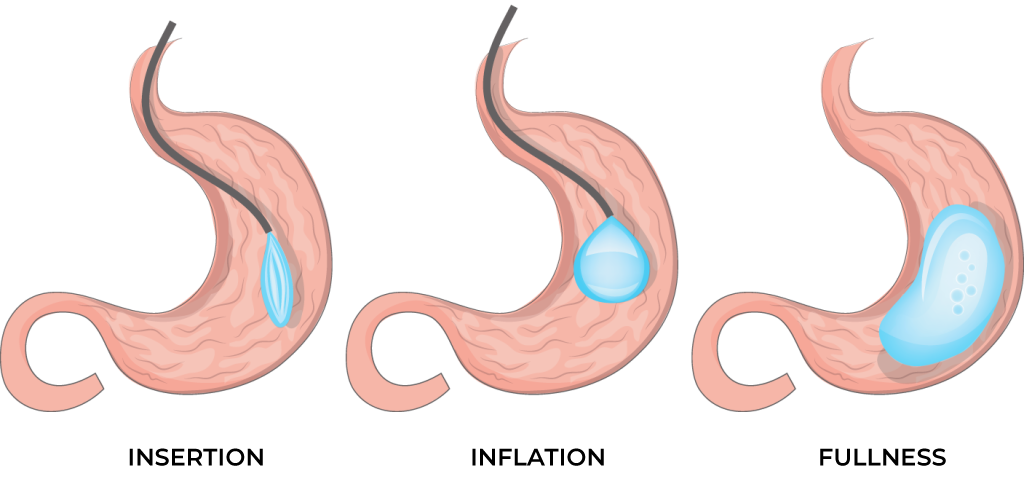Intragastric Balloon
WHAT IS INTRAGASTRIC BALLOON SURGERY?
Intragastric balloon surgery involves endoscopically placing a soft silicone balloon into the stomach via the mouth, which is then filled with sterile fluid.
This filled balloon takes up space in your stomach and means you feel full more easily, and as a result eat less. The procedure is only temporary, and the balloon is usually removed after six months.
The procedure is useful if you don’t meet the criteria for the other types of surgery – for example, your BMI (body mass index) is too high, or surgery is too high risk or complex, because of multiple previous open surgeries that did not involve your stomach.
Procedure
An intra-gastric balloon procedure is carried out without making an incision on your abdomen. Instead, the balloon is passed through your mouth and down into your stomach using an endoscope (a thin, flexible tube that has a light and a camera on one end).
Bariatrics – balloon stomach for weight loss

IS AN INTRAGASTRIC BALLOON PROCEDURE RIGHT FOR ME?
Professor Purkayastha explains the benefits of an Intragastric Balloon, and for which people this may be a better choice of surgery.
LET US EXPLAIN HOW WE CAN HELP YOU
Speak with our friendly patient concierge team, and let us answer any questions you have about weight loss surgery.
SOME IMPORTANT INFORMATION ABOUT INTRAGASTRIC BALLOON
Here are some questions about intragastric balloon surgery we are frequently asked by patients. We believe it is important you have all the information you require, so you can make an informed decision if surgery is the right option for you.
People who choose intragastric balloon surgery can enjoy a simple, non-permanent and reversible procedure that will help them to reduce the amount of food eaten at meals over a period of 6 to 12 months. The procedure involves fitting a small silicone balloon in the upper section of the stomach, reducing the stomach capacity.
The balloon can be removed after 6 or 12 months, or an adjustable balloon fitted which can be refilled.
Although each individual is different, someone who has an intragastric balloon fitted can lose up to 20kgs of excess body weight.
The positive health outcomes from the intragastric balloon include weight loss and the reduction of conditions related to increased weight. This includes but not limited to:
- Type 2 Diabetes
- High Cholesterol
- High Blood Pressure
- Heart Disease
- Stroke
- Mobility issues
- Joint pains
- Cancer
- Sleep Apnoea
- Infertility
Weight loss and better health can also improve the quality of your life and mental health, boosting self confidence and opening up new doors for how you want to live your life
Professor Puraksyastha will walk you through the preparation steps in the weeks leading up to your intragastric balloon surgery. The support you are given is tailored to you, following full metabolic, dietetic and psychological assessments. This is to ensure the best preparation and outcomes possible.
Our specialist dietitian will help you to prepare for your intragastric balloon surgery by undergoing a pre-operative liver-reduction diet lasting two weeks. The diet is low in fat and moderate in protein and low in calories, providing approximately 800-1000 kcal per day. The aim of the pre-operative diet is to shrink your liver meaning it can be moved more easily, making the operation safer. In the 24 hours before your surgery, you will be required to restrict your food and drink intake.
Our specialist psychotherapists will also help you to be best prepared for your surgery, ensuring you have the psychological support to ensure best outcomes.
The intragastric balloon procedure is more simple than other bariatric surgeries and so recovery is quicker. There are still post-surgery dietary and lifestyle changes that should be followed to enhance the effective of the procedure.
Dietary changes
There are three stages of texture modification diet following surgery, starting with a liquid diet and gradually building this back up to a long term, solid textured food.
Your specialist dietitian will help explain and guide your through the post-operative diet which follows the below stages:
- liquid diet (10 days)
- puree diet (3-4 weeks)
- soft diet (for around 6 weeks)
This is followed by a lifelong healthy, high protein diet of a normal solid texture from 12 weeks onwards.
Fluid intake remains important and you should aim to drink 1.5 litres a day. Avoid high calorie fluids including hot drinks made with sugar and fizzy drinks as these can cause bloating and discomfort.
Alcohol should not be taken for three months after surgery and after this time in moderation after food.
To ensure the balloon is not damaged by excess stomach acid, you will need to take acid-reducing tablets each day for the duration of when your balloon is fitted.
Lifestyle changes
Exercise – After surgery we advise you to move around as much as possible and ensure that you don’t get dehydrated. Exercise should be gentle for the two months – i.e. swimming, walking, cycling. No heavy lifting or weight training for at least eight weeks
In the long-term increased activity levels are needed alongside a reduced dietary intake for optimal and sustained weight loss after bariatric surgery.
Driving – You should not drive for the first two weeks following surgery and contact your insurance to find out what their guidelines are.
We suggest that when you are ready to drive that you ask a family member or a friend to drive you to a quiet street where you can attempt an emergency stop. If it feels comfortable then it is fine for you to drive.
Travel – We advise that you do not take a long haul flights for 8 weeks following your surgery
You can take flights of no more than 2 hours duration from two weeks after your surgery
Pregnancy – We advise you to avoid pregnancy for 2 years after surgery. Oral contraception can be restarted 1 month after surgery
Smoking – It is strongly advised to quit smoking in the long-term as this can undo the positive health outcomes from surgery, and increases risk of ulceration in the gastric pouch, chest infections, cancers and heart disease.
After your recovery period has ended, you can start to enjoy the lifestyle changes that come about from better health and increased mobility associated with Gastric Sleeve surgery.
Your aftercare package includes prolonged support from Mr. Purkayastha and your specialist dietitian, as well as the wider Surgical WeightMatters team.
You will have in-person follow-up appointments with Mr. Purkayastha arranged 7-10 days, 3 months, 6 months and 12 months after surgery with the option of additional follow-up appointments to check in with your progress.
You will have several post-operative appointments with your specialist dietitian as well, which are spread over 2 years after your surgery and tailored to suit your needs.
There is no limit to how many sessions you can have with the Surgical WeightMatters team. We are with you every step of the way to ensure the best support and outcomes possible.
My Purkayastrha will take time to talk you through the risks involved with intragastric balloon surgery and ensure you are fully informed before deciding which option you wish to have.
Every effort ensures these risks are avoided, and Mr Purkayastha is an extremely experienced bariatric surgeon. However, the short and long-term risks involved with intragastric balloon surgery are as follows:
Short-term risks:
- Pain
- vomiting
- Bleeding
- Infection of the wound
- Adverse reactions to anaesthesia
- Blood clots
- Breathing problems
- Leaks from the cut edge of the stomach
- Potential complications from nutritional deficiencies
- Dumping syndrome
Long-term risks:
- Gastrointestinal obstruction
- Hernias
- Gastroesophageal reflux
- Low blood sugar (hypoglycemia)
- Malnutrition, food intolerances or Dumping Syndrome
- Vomiting
- Blood clotting
- Stomach ulcers
- Barrett’s oesophagus
Weight regain, if diet and lifestyle changes are adhered to lifelong habits
Complications during surgery can result in elective or emergency medical or surgical (reoperation) treatment.
The intragastric balloon is a temporary fitting, usually lasting for 6 months and fitted to aid your short term weight loss goals. After 6 months your balloon will need to be removed. This is a simple procedure where the balloon is deflated and removed.
You do not need to stay overnight in hospital for this procedure as it is relatively quick and simple. Once your balloon is removed, your stomach will return to its original volume, so it is important to have your healthy diet and lifestyle habits in place to continue weight loss after the balloon is removed. My Purkayastha and the Surgical WeightMattersa team will ensure you are ready and prepared for the removal of your balloon.
You can opt to have a balloon fitted that is adjustable rather than removable. This is when the balloon is refilled to maintain the reduced capacity of the stomach. Mr Purkayastha can advise you on which option is best for you. The Surgical WeightMatters team will support you in arranging appointments to refill your balloon and maintain healthy diet and lifestyle habits alongside.
NEXT STEPS
If you are interested in an Intragastric Balloon procedure and still have some questions, please book a complimentary call with our friendly Patient Concierge team.
They will listen to your story, answer your questions, and ask about your health goals. If you are ready, they will get you booked in to meet your surgeon for a pre-surgery metabolic assessment and consultation.
- Review of your weight history
- Assessment of your current health picture
- Explore your motivation and goals
- Understanding your readiness and support structure
- Bespoke treatment pathway designed for you
- Build trust with your surgeon and care team
HOW MUCH DOES AN INTRAGASTRIC BALLOON PROCEDURE COST?
Please get in touch if you would like a quote for a balloon procedure.
You can find prices for our most popular procedures on the Gastric Sleeve, Gastric Bypass and Gastric Band pages.

